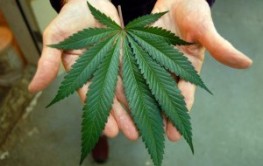Case Study Finds Teen’s Leukemia Well-Treated with Cannabis Oil
Case Study Finds Teen’s Leukemia Well-Treated with Cannabis Oil
( NaturalSociety ) Two Ontario-based doctors recently published in Case Reports in Oncology on the potentially promising treatment results of a 14-year old girl diagnosed with a very aggressive form of cancer—acute lymphoblastic leukemia with a Philadelphia chromosome mutation.

As Collective Evolutionreports, she underwent acute and aggressive chemotherapy treatments as well as bone marrow transplants in an effort to fight the disease. None of those conventional methods proved effective after 34 months. That’s when the girl’s family sought alternative options.
Cannabis oil, also known as hemp oil, is showing great promise in treating a variety of conditions as of late. It’s gained particular notoriety in the form of cannabidiol oil or CBD, used successfully in children with debilitating seizure disorders.
For this patient, doctors Yadvinder Singh, MD and Chamandeep Bali, ND say, the family began administering oral cannabinoid extracts (of the “Chronic Strain”) with promising results, saying it revealed a “rapid dose-dependent correlation.”
Initially, as the treatment began, she did experience some negative side effects including slight panic, nausea, increased appetite, and fatigue. But as time went on and tolerance was built, these lessened.
Her blast cell counts declined as the CBD oil dosages increased.
“The blast cell count reached a peak of 374,000 on the 25th February 2009 (day 5), followed by a decrease, which correlated with the increasing dose. The daily dosing is the amount administered per dose; the doses were initially given once per day up to a total of 3 times per day by day 15, and were continued with the same average frequency throughout the treatment. A decreased use of morphine for pain, an increase in euphoria symptoms, a disoriented memory and an increase in alertness were observed; these are typical with cannabinoid use.”
At one point, the family tried a different strain and had dramatically different results, with blast cell counts rising again and side-effects worsening. This is not unusual as cannabis strains can vary widely in their CBD concentrations. They followed this set-back with another strain-change.
Over a total treatment period of 78 days, improvement was measured.
“The results shown here cannot be attributed to the phenomenon of ‘spontaneous remission’ because a dose response curve was achieved. Three factors, namely frequency of dosing, amount given (therapeutic dosing) and the potency of the cannabis strains, were critical in determining response and disease control.”
The doctors say their goal in sharing the data from this singular case study is to encourage further research on the effects of cannabis oil in various cancer types.
“An emphasis needs to be placed on determining the correct cannabinoid ratios for different types of cancer, the best method of administration, quality control and standardization of the cannabis strains and their growing conditions as well as therapeutic dosing ranges for various cancers contingent on staging and ages.”
All of this begins with greater access to testing for scientists and ultimately greater access to CBD for patients across the country.
Other Popular Stories:
Get The NaturalSociety Natural Health Newsletter!
Post a Comment